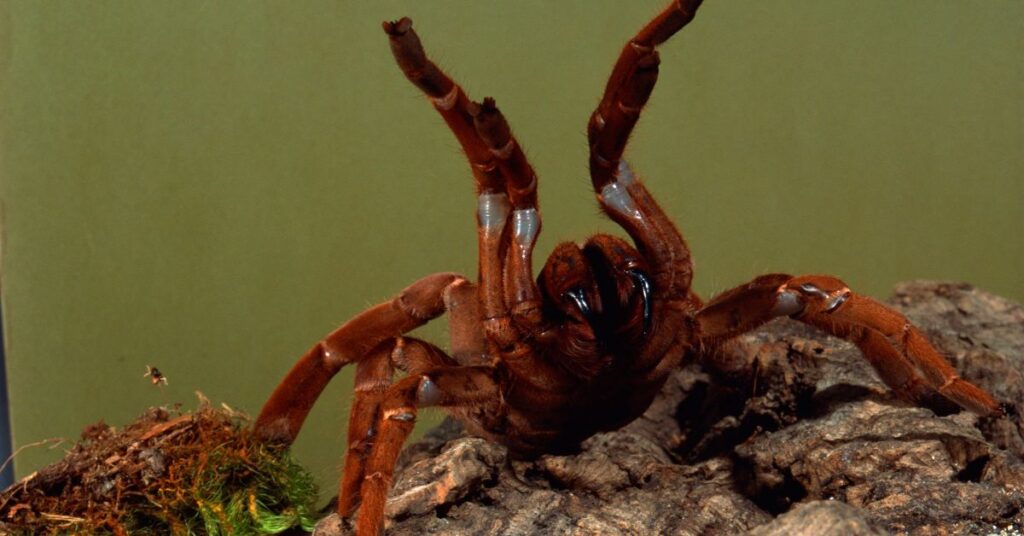
Most people either love or hate spiders. But are tarantulas dangerous? In this article, we aim to find out exactly just that and break it down for you.
Now we’ve answered the main question, lets read some more about exactly how dangerous these critters are.
Can Tarantulas Bite?
Yes. Most tarantulas possess fangs large enough to break the skin of a human, however, this is usually done as a last resort.
In the first instance, tarantulas will rise up into a threat posture in an attempt to make themselves look bigger and more threatening.

All New World tarantulas have the ability to stridulate (kick hairs).
They do this by rubbing their back legs across their abdomen, sending small, sharp hairs into the air so would rather do this than actually bite.
These hairs can cause a significant irritation if they get caught in the eyes, throat (by breathing them in) and can cause severe itching if they land on your skin.

Old World tarantulas do not have this ability as they lack urticating (a stinging or prickling sensation like that given by a nettle) hairs so therefore rely on biting as their defence mechanism.
Biting in defence is always a last resort for tarantulas. They would much rather flee although the OBT (Orange Bitey Thing or Pterinochilus murinus as it is officially known) has a reputation for being particularly aggressive.
We have an article on what the difference is between a new world and old world tarantula here.
How Painful is a Tarantula Bite?
Most of the time, a bite from a tarantula is no more painful than a bee or wasp sting.
There will be redness with some swelling at the bite site.
However, just as some people are allergic to bee stings, some may be allergic to the bite of a tarantula.
If you are unfortunate, the spider will inject venom using his fangs. This isn’t always the case though, as tarantulas give “dry bites” simply in order to hurt allowing them to flee the area.
If venom is injected, side effects can range from a simple sting like feeling, to nausea, tremors, headaches, aching bones and chills.
What is the Most Dangerous Tarantula?

The title of the most dangerous tarantula definitely goes to the Poecilotheria genus. Find out more about them here.
Hobbyists report bites by this species occasionally result in hospitalization.
Symptoms to watch out for include localized pain and swelling, exhaustion, moderate to severe muscle cramping, laboured breathing and fever, sometimes delayed days after the initial bite.
What to Do if You See a Tarantula
Fortunately, if you live in the UK, you’re not likely to see a tarantula unless it is someone’s pet.
However, if you live in the US, tarantulas are found primarily in the southern and southwestern states but have been found as far north as Utah.
Arizona in particular has a wealth of tarantulas known as the Arizona Blond (Aphonopelma chalcodes). Read our article dedicated to the Arizona Blond here (link opens in new window).
Should a tarantula invade your home, unwanted, don’t panic! Follow these easy steps for safe removal:
Take a plastic cup (with a lid), making sure it is large enough to fit the tarantula in, and place it over the top of the spider.
(Note. If you feel uncomfortable doing this, another method is to place the cup on the floor with the opening pointing towards the spider and using an implement such as a soft brush, gently guide the tarantula into the cup. You can then rotate the cup so that the opening is facing the floor).
Slide the lid underneath the tarantula to close the cup.
Safely remove outside to a darkened area (preferably near a burrow).
Never try and pick the tarantula up directly as you could not only injure the tarantula, but you will scare it and most likely get bitten.
If you prefer to watch video, here’s a short clip showing wonderfully how how to utilize the above method.
Of course, there is always the alternative option of going “Aaaah! Massive spider! HUGE!”, running away and getting someone else to do it, no-one will think any less of you. Well…. 😉
If you encounter one in the wild, your best bet is to leave it alone and if you have been bitten, don’t worry, you may be ill, but you’re not going to die….probably.
